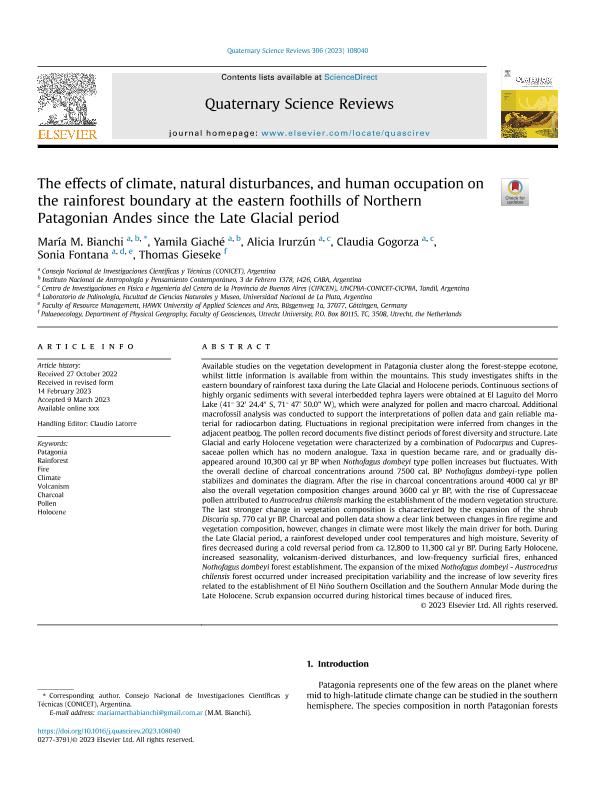Artículo
The effects of climate, natural disturbances, and human occupation on the rainforest boundary at the eastern foothills of Northern Patagonian Andes since the Late Glacial period
Bianchi, Maria Martha ; Giache, Yamila Soledad
; Giache, Yamila Soledad ; Irurzún, Alicia; Gogorza, Claudia Susana
; Irurzún, Alicia; Gogorza, Claudia Susana ; Fontana, Sonia Leonor; Gieseke, Thomas
; Fontana, Sonia Leonor; Gieseke, Thomas
 ; Giache, Yamila Soledad
; Giache, Yamila Soledad ; Irurzún, Alicia; Gogorza, Claudia Susana
; Irurzún, Alicia; Gogorza, Claudia Susana ; Fontana, Sonia Leonor; Gieseke, Thomas
; Fontana, Sonia Leonor; Gieseke, Thomas
Fecha de publicación:
04/2023
Editorial:
Pergamon-Elsevier Science Ltd
Revista:
Quaternary Science Reviews
ISSN:
0277-3791
Idioma:
Inglés
Tipo de recurso:
Artículo publicado
Clasificación temática:
Resumen
Available studies on the vegetation development in Patagonia cluster along the forest-steppe ecotone, whilst little information is available from within the mountains. This study investigates shifts in the eastern boundary of rainforest taxa during the Late Glacial and Holocene periods. Continuous sections of highly organic sediments with several interbedded tephra layers were obtained at El Laguito del Morro Lake (41° 32′ 24.4″ S, 71° 47’ 50.0” W), which were analyzed for pollen and macro charcoal. Additional macrofossil analysis was conducted to support the interpretations of pollen data and gain reliable material for radiocarbon dating. Fluctuations in regional precipitation were inferred from changes in the adjacent peatbog. The pollen record documents five distinct periods of forest diversity and structure. Late Glacial and early Holocene vegetation were characterized by a combination of Podocarpus and Cupressaceae pollen which has no modern analogue. Taxa in question became rare, and or gradually disappeared around 10,300 cal yr BP when Nothofagus dombeyi type pollen increases but fluctuates. With the overall decline of charcoal concentrations around 7500 cal. BP Nothofagus dombeyi-type pollen stabilizes and dominates the diagram. After the rise in charcoal concentrations around 4000 cal yr BP also the overall vegetation composition changes around 3600 cal yr BP, with the rise of Cupressaceae pollen attributed to Austrocedrus chilensis marking the establishment of the modern vegetation structure. The last stronger change in vegetation composition is characterized by the expansion of the shrub Discaria sp. 770 cal yr BP. Charcoal and pollen data show a clear link between changes in fire regime and vegetation composition, however, changes in climate were most likely the main driver for both. During the Late Glacial period, a rainforest developed under cool temperatures and high moisture. Severity of fires decreased during a cold reversal period from ca. 12,800 to 11,300 cal yr BP. During Early Holocene, increased seasonality, volcanism-derived disturbances, and low-frequency surficial fires, enhanced Nothofagus dombeyi forest establishment. The expansion of the mixed Nothofagus dombeyi - Austrocedrus chilensis forest occurred under increased precipitation variability and the increase of low severity fires related to the establishment of El Niño Southern Oscillation and the Southern Annular Mode during the Late Holocene. Scrub expansion occurred during historical times because of induced fires.
Palabras clave:
CHARCOAL
,
CLIMATE
,
FIRE
,
HOLOCENE
,
PATAGONIA
,
POLLEN
,
RAINFOREST
,
VOLCANISM
Archivos asociados
Licencia
Identificadores
Colecciones
Articulos(CCT - LA PLATA)
Articulos de CTRO.CIENTIFICO TECNOL.CONICET - LA PLATA
Articulos de CTRO.CIENTIFICO TECNOL.CONICET - LA PLATA
Citación
Bianchi, Maria Martha; Giache, Yamila Soledad; Irurzún, Alicia; Gogorza, Claudia Susana; Fontana, Sonia Leonor; et al.; The effects of climate, natural disturbances, and human occupation on the rainforest boundary at the eastern foothills of Northern Patagonian Andes since the Late Glacial period; Pergamon-Elsevier Science Ltd; Quaternary Science Reviews; 306; 4-2023; 1-14; 108040
Compartir
Altmétricas



